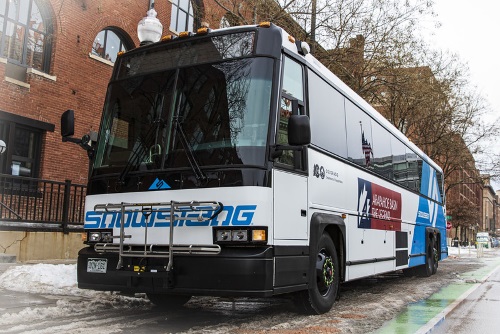A DePaul University report indicates the “prognosis” for the intercity bus sector remains “uncertain” due to its weakened financial condition from the COVID-19 outbreak alongside “unanswerable questions” about the pace of recovery from the pandemic.
[Above photo by the Colorado DOT.]
The 26-page report also shows that, despite those COVID-19 related challenges, “signs of optimism” are emerging that the intercity bus industry – which includes state department of transportation-supported routes as well as Greyhound, Megabus, and other commercial bus services – will move from “the brink” onto a more solid financial footing in post-pandemic times.

“We believe that January [2021] brought a modest rebound over December [2020] travel levels, and that traffic will gradually build through mid-summer, when a more robust recovery will occur,” the university’s report noted. “Summer will bring more seasonal demand, and vaccines are likely to have been widely administered to all age groups by that time.”
It added that, although the pace of route development dramatically dropped due to the pandemic, intercity bus lines made a variety of strategic moves last year, including experimentation with new booking platforms and service enhancements. “These innovations will likely accelerate as demand gradually rebounds,” the report said.
For example, the Colorado Department of Transportation recently launched a new mobile application so Bustang Outrider users can purchase tickets in a “cash-free, contactless, and COVID-19 safe way.”
The agency developed its new mobile app in partnership with Masabi, the company that also created a mobile ticketing app for its Bustang CDOT’s Interregional Express bus service.
“This new mobile app will make ticket purchasing process simpler, safer and more convenient,” explained Kay Kelly, director of innovative mobility for the Colorado DOT, in a statement. “We’re looking forward to providing our passengers with a contactless and safe way to purchase their bus tickets anytime, anywhere.”
Other findings from DePaul’s report include:
- The duration of trips on the intercity bus network has lengthened markedly over the past several years due to schedule cuts before and during the pandemic.
- Schedule deterioration is detrimental to the traveler experience and could delay the pace of recovery for the intercity bus industry. If bus lines add back schedules in response to strengthening demand as the pandemic eases, some of these degradations could be reversed.
- However, intercity buses remain the least expensive travel option on the vast majority of the country’s major routes. Yet persistently low air and rail fares pose an increasing threat on mid-distance and longer-haul routes.
- President Biden’s anticipated support for both Amtrak and public transit means “more forceful efforts” to leverage the combined strength of the bus and rail systems seem probable – fostering more “enhanced coordination” between intercity bus and Amtrak passenger rail services.
 Nation
Nation


